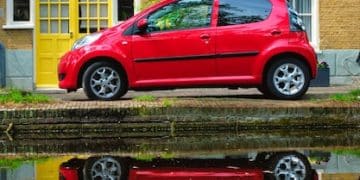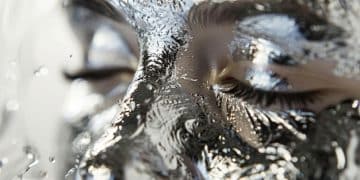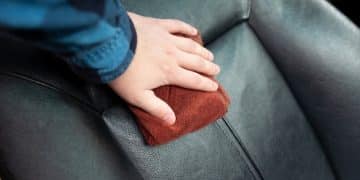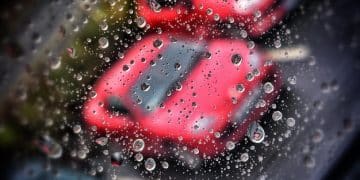Protect Your Car Paint: UV Damage and Fading Prevention
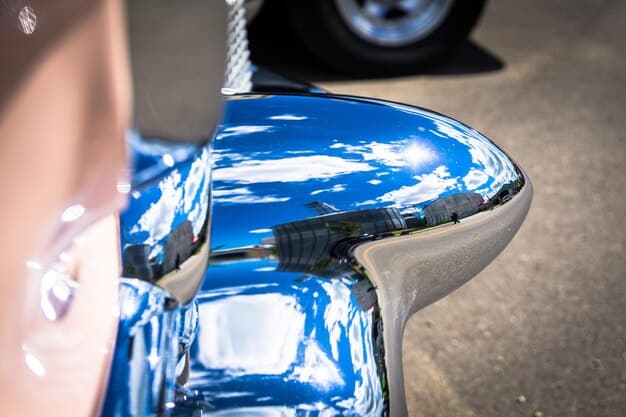
Protecting your car’s paint from UV damage and fading involves simple yet effective measures like regular washing, waxing, and applying paint protection films to shield it from the sun’s harmful rays, preserving its appearance and value.
Want to keep your car looking its best for years to come? Learn how to protect your car’s paint from UV damage and fading with these essential auto detailing tips, ensuring a vibrant and long-lasting finish.
Understanding UV Damage and Your Car’s Paint
The sun, while essential for life, can be a major enemy to your car’s paint. Understanding how ultraviolet (UV) rays damage your car’s finish is the first step in learning how to protect it.
These harmful rays break down the chemical bonds in your car’s paint, leading to fading, discoloration, and even cracking over time. Let’s delve into what makes UV rays so damaging and how they affect your vehicle.
Why UV Rays Are Harmful
UV rays are a form of electromagnetic radiation that have enough energy to cause chemical reactions. Two main types of UV rays affect car paint:
- UVA rays: These penetrate deep into the paint layers, causing fading and discoloration.
- UVB rays: These mainly affect the top coat, leading to oxidation and clear coat failure.
Both types of UV rays constantly bombard your car’s surface, making it crucial to take proactive steps to protect it.
Visible Signs of UV Damage
Recognizing the signs of UV damage can help you take early action. Here are some common indicators:
- Fading: Colors become less vibrant and lose their original intensity.
- Oxidation: The paint surface appears dull and chalky.
- Cracking: Small cracks appear in the clear coat, leading to more significant damage.
- Peeling: The clear coat starts to peel away, exposing the base coat.
The longer these signs are ignored, the more extensive and costly the repairs will be. So, let’s move on to the next point.
In conclusion, understanding the mechanisms and signs of UV damage is crucial for taking the necessary steps to protect your car’s paint. By recognizing these factors early, you can implement effective strategies to keep your car looking its best for years to come.
Regular Washing: The Foundation of Protection
Regular washing is the most basic, yet crucial, step in how to protect your car’s paint from UV damage and fading. Washing removes dirt, pollutants, and other contaminants that can exacerbate UV damage and accelerate the fading process.
By establishing a consistent washing routine, you can significantly extend the life and vibrancy of your car’s paint. Lets dive into the best practises to follow.
Best Washing Practices
To maximize the benefits of washing, follow these best practices:
- Use pH-balanced car wash soap: Avoid household detergents, which can strip away wax and damage the paint.
- Wash frequently: Aim to wash your car at least every two weeks, or more often if you live in a dusty or polluted area.
- Use the two-bucket method: Fill one bucket with soapy water and the other with clean water for rinsing your wash mitt. This prevents dirt from being reintroduced to the paint surface.
These steps will maintain your vehicle looking great for longer.
The Two-Bucket Method Explained
The two-bucket method is a simple yet effective technique to prevent scratches and swirl marks during washing:
- Fill one bucket with car wash soap and water.
- Fill the other bucket with clean water.
- Dip your wash mitt into the soap bucket, wash a section of the car, and then rinse the mitt in the clean water bucket.
- Repeat the process, always rinsing the mitt in the clean water before re-dipping into the soap bucket.
This ensures that dirt and debris are removed from the mitt before it touches the paint again.
Ultimately, regular and proper washing not only keeps your car looking clean but also lays the foundation for more advanced protection methods. By removing contaminants that accelerate UV damage, you pave the way for the application of wax, sealants, and other protective coatings that further shield your car’s paint.
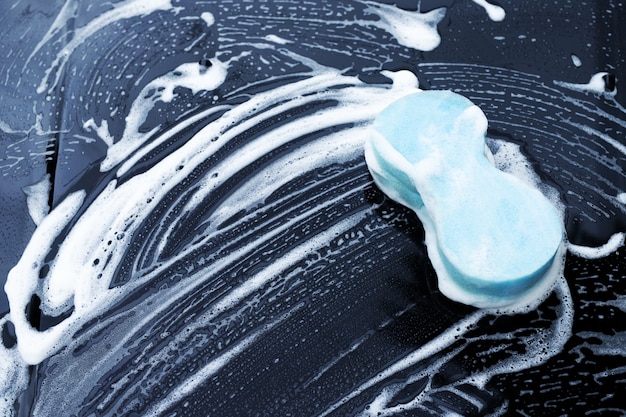
The Power of Waxing: Adding a Protective Layer
Waxing is another essential step in how to protect your car’s paint from UV damage and fading. Wax creates a protective barrier between the paint and the environment, shielding it from UV rays, pollutants, and other harmful elements.
Regular waxing not only enhances the appearance of your car but also prolongs the life of its paint. Here’s everything you need to know about choosing and applying wax.
Choosing the Right Wax
There are several types of car wax, each with its own benefits:
- Carnauba wax: Known for its natural shine and protective properties, carnauba wax provides a deep, rich gloss. However, it typically lasts only a few weeks to a couple of months.
- Synthetic wax: These waxes offer longer-lasting protection and are more resistant to heat and UV rays compared to carnauba wax.
Select one that aligns with your car and preferences.
How to Apply Wax Properly
Proper application is key to maximizing the protective benefits of wax:
- Wash and dry the car: Ensure the surface is clean and free of any contaminants.
- Apply a thin, even layer: Use an applicator pad to apply the wax in a circular motion.
- Let it haze: Allow the wax to dry until it forms a haze.
- Buff off: Use a clean microfiber cloth to buff off the haze, revealing a glossy finish.
Avoid applying wax in direct sunlight, as this can cause it to dry too quickly and become difficult to buff off.
In summary, waxing is a crucial step in your car care routine, providing a sacrificial layer that protects your paint from the damaging effects of UV rays and environmental contaminants. By choosing the right wax and applying it correctly, you can significantly extend the life and vibrancy of your car’s finish, keeping it looking newer for longer.
Paint Protection Film (PPF): The Ultimate Shield
For the ultimate protection against UV damage and fading, consider investing in paint protection film (PPF). PPF is a thin, transparent urethane film that is applied to the surface of your car, providing a physical barrier against UV rays, scratches, and other types of damage. Here’s why PPF is an excellent option.
It safeguards the originality of your car. PPF creates a barrier against everyday road hazards, keeping your vehicle looking newer for longer.
Benefits of PPF
PPF offers numerous advantages:
- Superior UV protection: Blocks virtually all UV rays from reaching the paint.
- Scratch resistance: Protects against scratches, swirl marks, and minor impacts.
- Self-healing properties: Some PPF films can self-heal minor scratches and swirl marks with heat.
Investing in PPF is a worthwhile investment for preserving the appearance of your vehicle.
Installation and Maintenance
PPF should be professionally installed for the best results:
- Professional installation: Ensures proper adhesion and a seamless finish.
- Regular cleaning: Wash the PPF-covered areas regularly with a mild car wash soap.
- Avoid harsh chemicals: Refrain from using abrasive cleaners or solvents that can damage the film.
With proper care, PPF can last for several years, providing long-lasting protection for your car’s paint.
In conclusion, paint protection film represents the most robust solution for shielding your car’s paint from UV damage and a host of other environmental threats. While it requires a more significant upfront investment compared to waxing or sealants, the long-term benefits in terms of superior protection, scratch resistance, and potential self-healing properties make it a worthwhile consideration for those serious about preserving their vehicle’s appearance.
Ceramic Coatings: A Modern Solution
Ceramic coatings have gained popularity as an advanced method to protect car paint from UV damage and fading. These coatings are liquid polymers that chemically bond to the paint, creating a hard, transparent layer that offers excellent protection. Ceramic coatings provide benefits beyond traditional products. Let’s explore some of the highlights.
Ceramic coatings enhance the appearance of your car while providing a powerful protection against environmental threats.
Advantages of Ceramic Coatings
Ceramic coatings offer several key benefits:
- Long-lasting protection: Provides years of protection with a single application.
- Hydrophobic properties: Repels water, making it easier to wash and dry the car.
- UV resistance: Blocks UV rays, preventing fading and discoloration.
These benfits make ceramic coatings a popular option among car owners.
Application and Upkeep
Like PPF, ceramic coatings require professional installation:
- Professional application: Necessary for proper bonding and optimal performance.
- Regular maintenance washes: Use pH-neutral car wash soap to maintain the coating’s hydrophobic properties.
- Avoid abrasive cleaners: Do not use harsh chemicals or abrasive polishes.
Following these steps ensures the coating’s longevity and effectiveness.
Ultimately, ceramic coatings represent a significant advancement in automotive paint protection technology, offering a blend of long-lasting protection, UV resistance, and easy maintenance benefits. While the initial investment might be higher than traditional waxes or sealants, the extended lifespan and enhanced properties make it a compelling option for those seeking a superior and more durable solution to preserve the appearance and value of their vehicle. By entrusting the application to professionals and adhering to proper maintenance practices, you can ensure that your ceramic coating provides years of reliable protection against UV damage and fading.
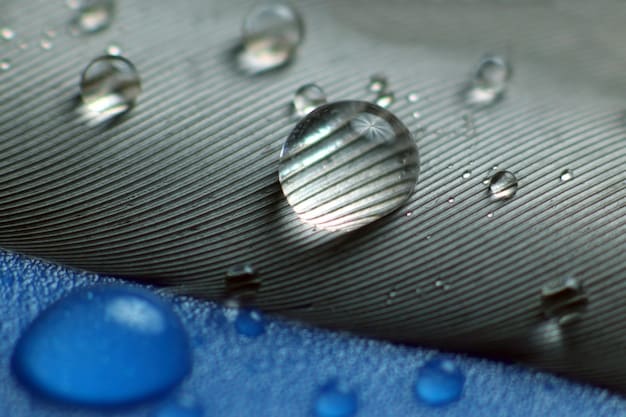
The Role of Garages and Car Covers
Parking your car indoors or using a car cover are simple yet effective ways to minimize UV exposure. Garages and car covers provide a physical barrier that shields your car’s paint from direct sunlight, reducing the risk of fading and damage. Let’s consider some tips for using these.
These options are especially helpful for cars that are frequently exposed to the sun. Explore these options and tips on how to best take advantage of them.
Using Garages Effectively
Here are some tips for using a garage to protect your car:
- Park indoors: Always park your car in the garage when it’s not in use.
- Keep the garage clean: Dust and debris can scratch the paint if they come into contact with the car’s surface.
- Ventilate the garage: Ensure proper ventilation to prevent moisture buildup, which can lead to rust and corrosion.
Ventilation and a clean garage are key to fully take advantage of this strategy.
Choosing and Using Car Covers
When a garage isn’t available, a car cover can provide similar protection:
- Select a breathable cover: Choose a cover made from breathable material to prevent moisture buildup.
- Ensure a snug fit: A well-fitting cover will stay in place and provide maximum protection.
- Clean the car before using the cover: Dirt trapped under the cover can scratch the paint.
Also be careful to not use in windy conditions.
In summary, utilizing garages and car covers represents a practical and cost-effective approach to minimizing UV exposure and safeguarding your car’s paint. Whether you have access to a garage or rely on car covers, these strategies serve as a consistent barrier against the sun’s harmful rays, preventing fading, discoloration, and other forms of UV damage. Integrating these practices into your routine, along with other measures like waxing and the application of paint protection films, can ensure that your car maintains its vibrant appearance and value for years to come.
| Key Point | Brief Description |
|---|---|
| 🧼 Regular Washing | Removes dirt that exacerbates UV damage and accelerates fading. |
| 🛡️ Waxing | Creates a protective barrier against UV rays and pollutants. |
| ☀️ PPF | Ultimate shield; blocks UV rays and prevents scratches. |
| 🚗 Garage | Parking indoor helps shield the car from sunlight. |
FAQ
▼
Ideally, wash your car every two weeks. If you live in a dusty or polluted area, consider washing it more often to remove contaminants that can accelerate UV damage.
▼
Synthetic waxes offer longer-lasting UV protection compared to carnauba wax. Look for waxes specifically formulated to resist UV rays for optimal defense.
▼
Yes, PPF provides superior UV protection and scratch resistance. It’s a worthwhile investment if you want to preserve your car’s appearance long-term.
▼
Yes, ceramic coatings block UV rays, preventing fading and discoloration. They also offer hydrophobic properties, making car washing easier.
▼
Absolutely. Parking in a garage or using a car cover reduces direct sunlight exposure, minimizing UV damage and keeping your paint looking newer for longer.
Conclusion
Protecting your car’s paint from UV damage and fading is an ongoing process that requires consistent effort. By following these auto detailing tips, including regular washing, waxing, applying paint protection film or ceramic coatings, and utilizing garages or car covers, you can significantly extend the life and vibrancy of your car’s finish, ensuring it looks its best for years to come.
